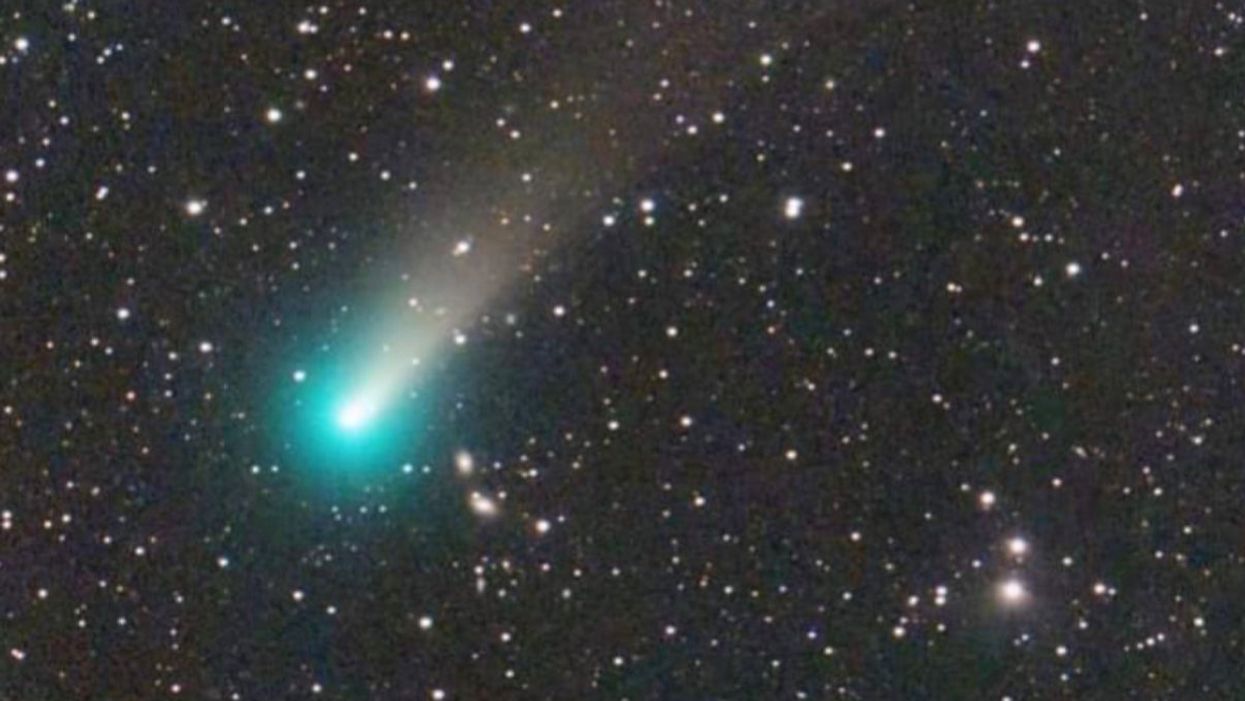Becca Monaghan
Dec 06, 2021
A dazzling green comet is set to light up the night sky this month as it passes Earth for the first time in 70,000 years.
The newly discovered Comet Leonard will likely become the brightest comet of the year following its long journey into the inner Solar System. It’s expected to be at its brightest and closest to Earth on December 12th (34.9 million km).
Catalogued as C/2021, Comet Leonard was discovered on January 3 by Senior research specialist Greg Leonard at the Mt. Lemmon Observatory. What was initially a faint, distant speck has soon inched closer to the Sun and Earth.
“I saw an object that was definitely real. It was tracking across four images against the background stars which appear stationary,” Leonard told Inverse .
The comet has a green tail due to its icy rock interior heating up the closer it gets to the sun. Once teal, it means the comet is warm and contains plenty of diatomic carbon, and the potential for it to break up is at its highest.
While the comet is visible right now across the world – unless you’re in Antarctica, according to astronomer Ed Krupp, you will require binoculars or a telescope to see it.
“The comet will just be about half the width of a clenched fist to the left” of Arcturus, Krupp said. “You might spot it with the unaided eye, but more likely, you’re going to need binoculars [or] a telescope.”
Sign up to our new free Indy100 weekly newsletter
On Monday (December 6), it will appear to the left of the star Arcturus, a “bright orange star not to be missed.”
Brits, however, are best to start gazing in the early hours of 04:00 GMT on December 10. People in North America and the Southern Hemisphere should get their best view on December 14.
On December 17, it should pass close to planet Venus.
Due to the comet’s unpredictable behaviour, it could stay relatively dim, or it may flare up in the sky.
Some lucky people stargazers have already witnessed the bright green iceball and have turned to its official account to showcase their stunning skylines.
Comet Leonard taken in the early hours this morning #Astrophotography https://t.co/IvnPMwVO1H— Mountains of Scotland (@Mountains of Scotland) 1638908242
Comet Leonard took a cruise past the massive M3 cluster the other day. 2021 is giving us stargazers a little treat… https://t.co/hGzOL29plU— Tyler Jay (@Tyler Jay) 1638829843
Bigger? Better? Slowly getting there! https://t.co/flIAWce1Js— C/2021 A1 (Comet Leonard) (@C/2021 A1 (Comet Leonard)) 1638653143
We have hit the verge! Keep your eyes peeled dark sky astronomers. 👀👀 https://t.co/xOt5U4mp9z— C/2021 A1 (Comet Leonard) (@C/2021 A1 (Comet Leonard)) 1638571457
Comet Leonard and the M3 star cluster rising over the Blue Ridge Mountains early this morning. She's starting to pu… https://t.co/SfA48dgwmc— Brennan Gilmore (@Brennan Gilmore) 1638561689
#レナード彗星 #C2021A1 #cometLEONARD #M3 本日3:21から4:37の間の移動の様子 30s×141コマ α7SIII + BORG71flレデューサー0.72 https://t.co/qh4b5qhWoF— simao (@simao) 1638396406
Comet C/2021 A1 Leonard early this morning over Charlottesville. Beautiful bright comet! Shot at 400mm and tracke… https://t.co/P4sGP0Y5zv— Peter Forister ❄️💨❄️ (@Peter Forister ❄️💨❄️) 1638374666
Comet Leonard reaches closest to the sun on January 3 before heading back out to the outer wastes of the Solar System.
It will be around 80,000 years until anyone on Earth sees it again.
Top 100
The Conversation (0)













